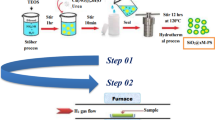Abstract
The effect of the metal center of [ML] complexes [M = Ni(II), Cu(II); L = N,N′-ethylenebis(acetylacetoniminato)] on their electrochemistry and electrocatalytic activity for the reduction of CO2 and protons has been studied using cyclic voltammetry and bulk electrolysis. The two complexes exhibit different electrochemistries, which are not significantly dependent on the nature of the solvent. The electrocatalytic activity of [NiL] is significantly higher than that of [CuL] for CO2 reduction, due to the higher stability of the electrochemically generated [Ni(I)L] complex, relative to the Cu(I) analog. The diffusion coefficient of [NiL] calculated from the steady-state diffusion limiting current is 3.0 × 10−6 cm2 s−1. The catalytic efficiency of [NiL] in non-aqueous solvents in terms of i p(CO2)/i p(N2) per nickel center is smaller than that of [Ni(cyclam)]2+, but greater than those of sterically hindered mononuclear [Ni(1,3,6,8,10, 13,15-heptaazatricyclo(11.3.1.1) octadecane)]2+ or multinuclear [Ni3 (X)]6+ where X = 8,8′,8″-{2,2′,2″(-nitrilotriethyl)-tris(1,3,6,8,10,13,15-heptaazatricyclo(11.3.1.1) octadecane}. Both [NiL] and [CuL] are also electrocatalysts for the reduction of carboxylic acid protons, with the catalytic pathway being different for acetic and trifluoroacetic acids in MeCN.











Similar content being viewed by others
References
Fisher BJ, Eisenberg R (1980) J Am Chem Soc 102:7361–7363
Fujita E, Szalda DJ, Creutz C, Sutin N (1988) J Am Chem Soc 110:4870–4871
Fujita E, Creutz C, Sutin N, Szalda DJ (1991) J Am Chem Soc 113:343–353
Olson DC, Vasilevskis J (1971) Inorg Chem 10:463–470
Mochizuki K, Manaka S, Takeda I, Kondo T (1996) Inorg Chem 35:5132–5136
Yatsimirskii K (1990) Russ Chem Rev 59:1150–1156
Yin X, Moss JR (1999) Coord Chem Rev 181:27–59
Schneider J, Jia H, Kobiro K, Cabelli DE, Muckerman JT, Fujita E (2012) Energy Environ Sci 5:9502–9510
Dubois MR, Dubois DL (2009) Acc Chem Res 42:1974–1982
Benson EE, Kubiak CP, Sathrum AJ, Smieja JM (2009) Chem Soc Rev 38:89–99
Ostapowicz TG, Holscher M, Leitner W (2012) Eur J Inorg Chem 34:5632–5641
Vidal AB, Feria L, Evans J, Takahashi Y, Liu P, Nakamura K, Illas F, Rodriguez JA (2012) J Phys Chem Let 8:2275–2280
DuBois DL (2007) In: Bard AJ (ed) Encyclopedia of electrochemistry. Wiley-VCH, Weinheim
Schneider J, Jia H, Muckerman JT, Fujita E (2012) Chem Soc Rev 41:2036–2051
Xu Z, McNamara ND, Neumann GT, Schneider WF, Hicks JC (2013) Chem Cat Chem 5:1769–1771
Angamuthu R, Byers P, Lutz M, Spek AL, Bouwman E (2010) Science 327:313
Rudolph M, Dautz S, Jäger EG (2000) J Am Chem Soc 122:10821
Costentin C, Drouet S, Robert M, Saveant JM (2012) Science 338:90–94
Sullivan BP, Krist K, Guard H (1993) Electrochemical and electrocatalytic reactions of carbon dioxide. Elsevier, Amsterdam
Froehlich JD, Kubiak CP (2012) Inorg Chem 51:3932–3934
Fujita E, Haff J, Sanzenbacher R, Elias H (1994) Inorg Chem 33:4627–4628
Meshituka S, Ichikawa M, Tamaru K (1974) Electrocatalysis by metal phthalocyanines in the reduction of carbon dioxide. J Chem Soc Chem Commun 5:158–159
Chang M, Saji T, Bard AJ (1977) J Am Chem Soc 99:5399
Bard AJ, Faulkner LR (2001) Electrochemical methods: fundamentals and applications, 2nd edn. Wiley, New York
Lee EY, Hong D, Park HW, Suh MP (2003) Eur J Inorg Chem 17:3242–3249
Beley M, Collin JP, Ruppert R, Sauvage JP (1984) J Chem Soc Chem Commun 19:1315–1316
Gupta SK, Hitchcock PB, Kushwah YS (2002) J Coord Chem 55:1401–1407
Choi MG, Kim MH, Kim HJ, Park J, Chang S (2007) Bull Korean Chem Soc 28:1818–1820
Bard AJ, Faulkner LR (2001) Electrochemical methods: fundamentals and applications, 2nd edn. Wiley, New York, pp 157–470
Desilvestro J, Pons S (1989) J Electroanal Chem 267:207–220
Balazs GB, Anson FC (1993) J Electroanal Chem 361:149–157
de Alwis C, Crayston JA, Cromie T, Eisenblatter T, Hay RW, Lampeka YD, Tsymbal LV (2000) Electrochim Acta 45:2061–2074
Grochala W (2006) Phys Chem Chem Phys 8:1340–1345
Fisher B, Eisenberg R (1980) J Am Chem Soc 102:7361–7362
Portenkirchner E, Oppelt K, Ulbricht C, Egbe DAM, Neugebauer H, Knör G, Sariciftci NS (2012) J Organ Chem. doi:10.1016/j.jorganchem.2012.05.021
Alhanash HBA (2012) Development of asymmetric ammonium-based room temperature ionic liquids https://www.escholar.manchester.ac.uk/api/datastream?publicationPid=uk-ac-man-scw:182019&datastreamId=FULL-TEXT.PDF. Accessed 10 Jul 2014
Acknowledgments
The authors gratefully acknowledge financial assistance from NSF of Sri Lanka through the research grant (RG/2006/FR/02), the Australian Research Council and an Endeavour Award-2011 Fellowship by DEEWR and AusAid of Australia to Dr. (Mrs.) M.Y.Udugala-Ganehenege. The authors extend their thanks to Prof. J. F. Endicott of Wayne State University, Detroit, MI 48202, USA, for reviewing the paper before submission.
Author information
Authors and Affiliations
Corresponding author
Electronic supplementary material
Below is the link to the electronic supplementary material.
Rights and permissions
About this article
Cite this article
Udugala-Ganehenege, M.Y., Dissanayake, N.M., Liu, Y. et al. Electrochemistry of nickel(II) and copper(II) N,N′-ethylenebis(acetylacetoniminato) complexes and their electrocatalytic activity for reduction of carbon dioxide and carboxylic acid protons. Transition Met Chem 39, 819–830 (2014). https://doi.org/10.1007/s11243-014-9864-3
Received:
Accepted:
Published:
Issue Date:
DOI: https://doi.org/10.1007/s11243-014-9864-3




